Corporations have taken over many military tasks or “base operations support services,” writes Christian Sorensen. Fourth in a five-part series on the military-industrial-congressional complex.

U.S. Department of Defense contractors prepare to engage targets at a live-fire range at Camp Leatherneck, Helmand province, Afghanistan, May 12, 2013. (DoD, Ezekiel R. Kitandwe)
Read Part 1, Part 2 and Part 3.
By Christian Sorensen
Special to Consortium News
 To make more money, more and more aspects of life must be pulled into capital. This is why we see everything in civilian life being commodified, including food, housing, land and water. And this is why corporations take over many military functions. A given corporation now in charge of what was once a governmental job needs to get a layer of profit out of the task. To obtain that profit the corporation ends up over-charging, cutting jobs,polluting, and/or harming unions.
To make more money, more and more aspects of life must be pulled into capital. This is why we see everything in civilian life being commodified, including food, housing, land and water. And this is why corporations take over many military functions. A given corporation now in charge of what was once a governmental job needs to get a layer of profit out of the task. To obtain that profit the corporation ends up over-charging, cutting jobs,polluting, and/or harming unions.
Corporate America is in charge of the tasks that keep a military installation up and running. They call it “base operations support services,” or BOSS — one of the many business sectors of war. Corporations selling BOSS usually provide a combination of facility management, fire and emergency services, grounds maintenance, janitorial services, pavement clearance, pest control and waste management. These basic duties used to be done by soldiers, sailors, airmen and Marines.
The cost of paying a corporation for BOSS is “higher than paying government employees or soldiers” to do it “because of the profit motive involved” the International Business Times has reported. EMCOR, Fluor, IAP, KBRWyle, Pride, Vectrus and TRAX International are some of the big-name corporations selling BOSS. U.S. citizens and residents getting paid a paltry wage carry out most BOSS stateside. Third-country nationals (TCN) — neither locals nor U.S. citizens — carry out BOSS overseas, often in poor working conditions. This evidences the fact that workers of the world have more in common with one another than they do with the ruling class.

Contractor PAE’s galley staff receive a visit from U.S. Army General William E. Ward, at left, at Camp Lemonnier, a U.S. Navy facility in Djibouti, 2010. (U.S. Army Africa, Elitre, CC BY 2.0, Wikimedia Commons)
Business sectors of war are military functions that corporations now run. Most large war corporations specialize in multiple business sectors of war.
One of the most visible business sectors of war is the design and production of platforms. Platforms include piloted aircraft, drones (in the air, on the sea, under the sea), surface ships, submarines and land vehicles. Most people see an aircraft or a ship or a vehicle. War corporations see a platform upon which to route goods and services.
Take the General Atomics MQ-9 drone. It’s a General Atomics product, sure, but many corporations produce goods and services for the platform. Honeywell makes the engine. Boeing, Lockheed Martin, General Dynamics, and Raytheon make the bombs and missiles. L3Harris makes the training system and performs depot maintenance, and Raytheon produces both the targeting sensor and the radar warning receiver. And on and on.
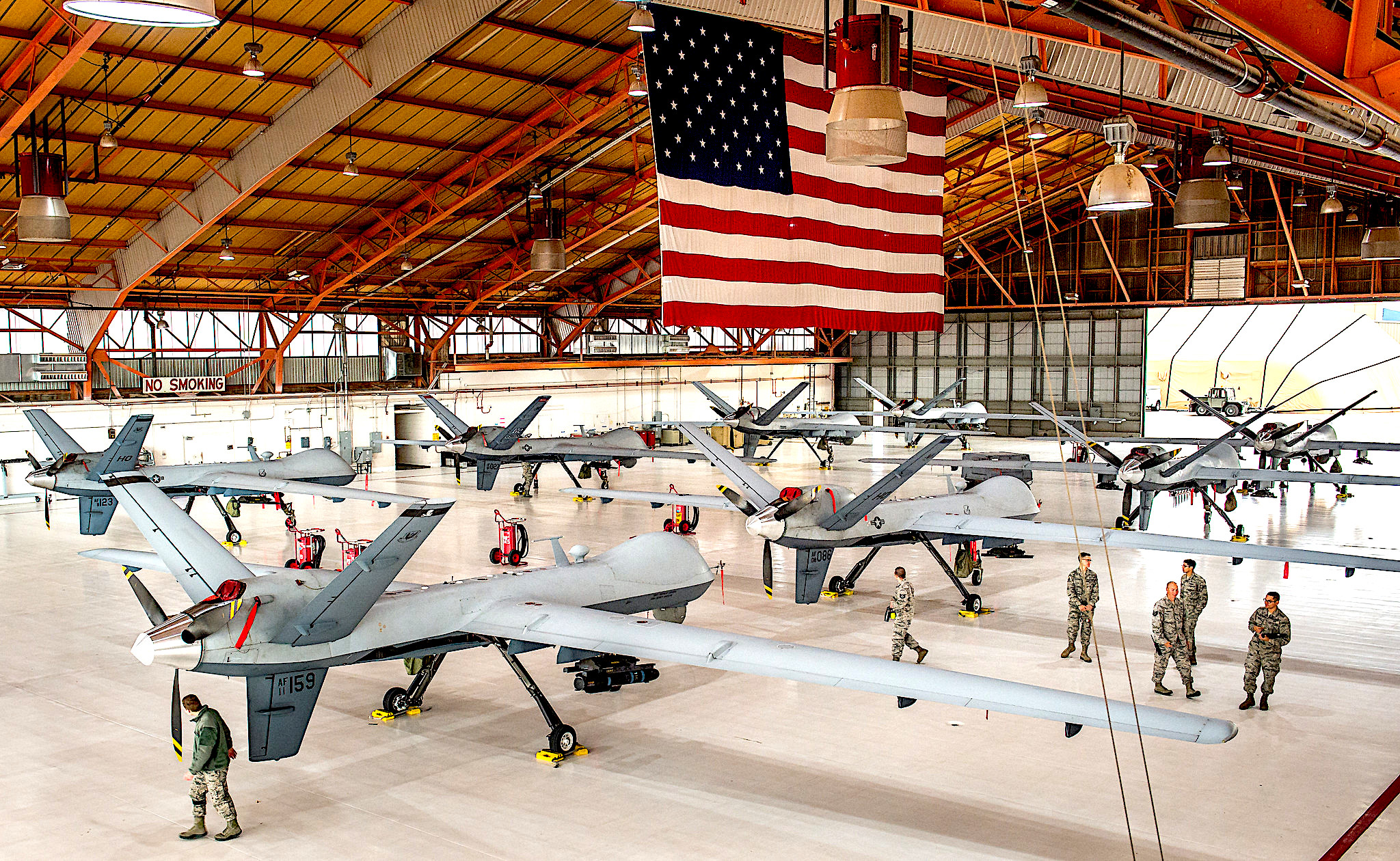
MQ-9 “Reaper” remotely piloted aircraft lined up in hanger at Holloman AFB, N.M., 2016. (U.S. Air Force, J.M. Eddins Jr.)
Intel, Inc.
Intelligence is increasingly corporatized, and IT-intensive. Most intelligence positions within the enormous U.S. intelligence community are people sitting at desks. Contractors comprise the bulk of the workforce in both military and civilian intelligence agencies. The major corporations that sell intel goods and services and fill out the employee rosters at IT-heavy intelligence organizations include Accenture, Booz Allen Hamilton, CACI, Carahsoft, General Dynamics, Leidos, L3Harris, ManTech, PAE and SAIC.
Other business sectors of war include propaganda and public relations; office work and program management; consulting and advisory and assistance; finance and accounting; training and simulation; transportation; cataloguing, maintaining and guarding “prepositioned stock,” which is war matériel and weaponry sitting at strategic locations around the world; telecommunications; nuclear weaponry; anti-ballistic missiles and tracking; small arms and light weaponry; space (satellites, ground-based monitoring, launch vehicles, launch support, range operations); ordnance (bombs, missiles, artillery); and microelectronics.
Corporations are also in charge of recruitment and retention. Corporations sustain war by enticing youth to enlist. Most recruits actually don’t become cannon fodder, but rather serve as vessels for corporate goods and services. Major advertising firms, such as GSD&M, Wunderman Thompson, Young & Rubicam, and Blaine Warren, design and implement the military’s recruitment strategy, campaigns and advertisements.

Recruiting event at Columbine High School in Littleton, Colorado, March 21, 2017. (DoD,Benjamin Pryer)
Outfitting Special Ops
Special operations kit is another business sector. The war industry outfits special operations forces (SOF) like sporting goods companies outfit golfer Tiger Woods or basketball star LeBron James. Small arms & light weaponry, body armor, visual augmentation devices and munitions bedeck the operator.
Contracts for SOF gear can be very expensive. One issued on March 7, 2019, to six corporations, including the ever-present Atlantic Diving Supply, cost up to $4 billion. War corporations know precisely what they’re doing: special operations forces are vessels for industry goods and services.
Using supposedly necessary competition against Moscow and Beijing as an excuse, the Pentagon and the war industry are creating “hyper-enabled operators.” A hyper-enabled operator is an extra-packed vessel.
Hyper-enabling involves selling the military new technology for use on and through the operator, including biomedical monitoring, real-time social media monitoring and social network mapping, tools for long-distance identification, apps for data aggregation and rapid decision-making and instruments for tactical navigation. Hyper-enabled operators constitute an end-to-end digitization of war-fighting. And with full digitization of the grunts comes full opportunity for selling endless upgrades and follow-on goods and services.
IT Is About Profit

A traumatic brain injury patient walks through a virtual reality scenario at the Computer Assisted Rehabilitation Environment Laboratory at Walter Reed National Military Medical Center in Bethesda, Md., 2017. (U.S. Air Force, J.M. Eddins Jr.)
Information technology is the most profitable business sector of war. Networking equipment, servers, hardware, and software that process, relay, and distribute data are known as information technology (IT). The cloud (corporate computing power) and artificial intelligence are included in this business sector. IT-related contracts are more common than any other business sector of war.
The major U.S. corporations selling IT-related goods and services to the military establishment include Amazon, Booz Allen Hamilton, CACI, Dell, General Dynamics, L3Harris, HP, Microsoft, Oracle, SAIC, and Vectrus.

Booz Allen Hamilton office, Washington, D.C., 2017. (Wikimedia Commons)
The implicit mission of the U.S. military, and military intelligence in particular, is to cover the globe. The war industry seizes upon this boundless mission to market all manner of IT goods and services. With no strategy whatsoever in terms of overall military mission or acquisition, the U.S. military establishment eagerly gobbles up said goods and services.
A deluge of information results; the system is functionally overwhelmed. Or, rather, the system is overwhelming by its very nature. The flood of information then allows the war industry to develop, market and sell even more IT, including but not limited to software and hardware that aggregate or merge information, allegedly simplifying the big picture.
Connect it all becomes the motto and logical conclusion of such a fundamentally greedy system. One can see this today in industry’s push (again, citing such official enemies as Moscow and Beijing) to connect everything —aircraft, satellites, ships, artillery batteries, and other weapon systems — into a single network. The Combined Joint All-Domain Command & Control (CJADC2) system seeks to link and share information from all military sensors and shooters.
CJADC2 will incorporate artificial intelligence, or machine learning, in order to aid military and civilian decision-making. Designed and maintained by the war industry, and marketed as providing exquisite battlefield awareness, CJADC2 offers corporations endless sales, including upgrades and modifications, ensuring an inherently profitable future.
Please Support Our Spring Fund Drive!
Bureaucratic nooks and crannies provide further opportunities for corporate profit. And corporations jostling for elbowroom create more nooks and crannies within which to extract profit. Corporations carry out the work of every large military unit.
For example, Systems Commands are the primary large bureaucratic divisions within the U.S. Navy. Corporations have had great success assuming dominion across large swaths of Systems Commands. Another example is Unified Combatant Commands, broad units of control organized based on function (e.g. Special Operations Command, Transportation Command) or geographical jurisdiction (e.g. Africa Command, Southern Command).
Corporations work on program management, business processes, planning and analysis, policy recommendations, and acquisition in these commands. If high-ranking military officials cannot handle paperwork or manage programs, what good are they? That issue does not concern the corporation, which profits from the neoliberal push for privatization and incompetent or apathetic military leadership.
DOD, Inc.
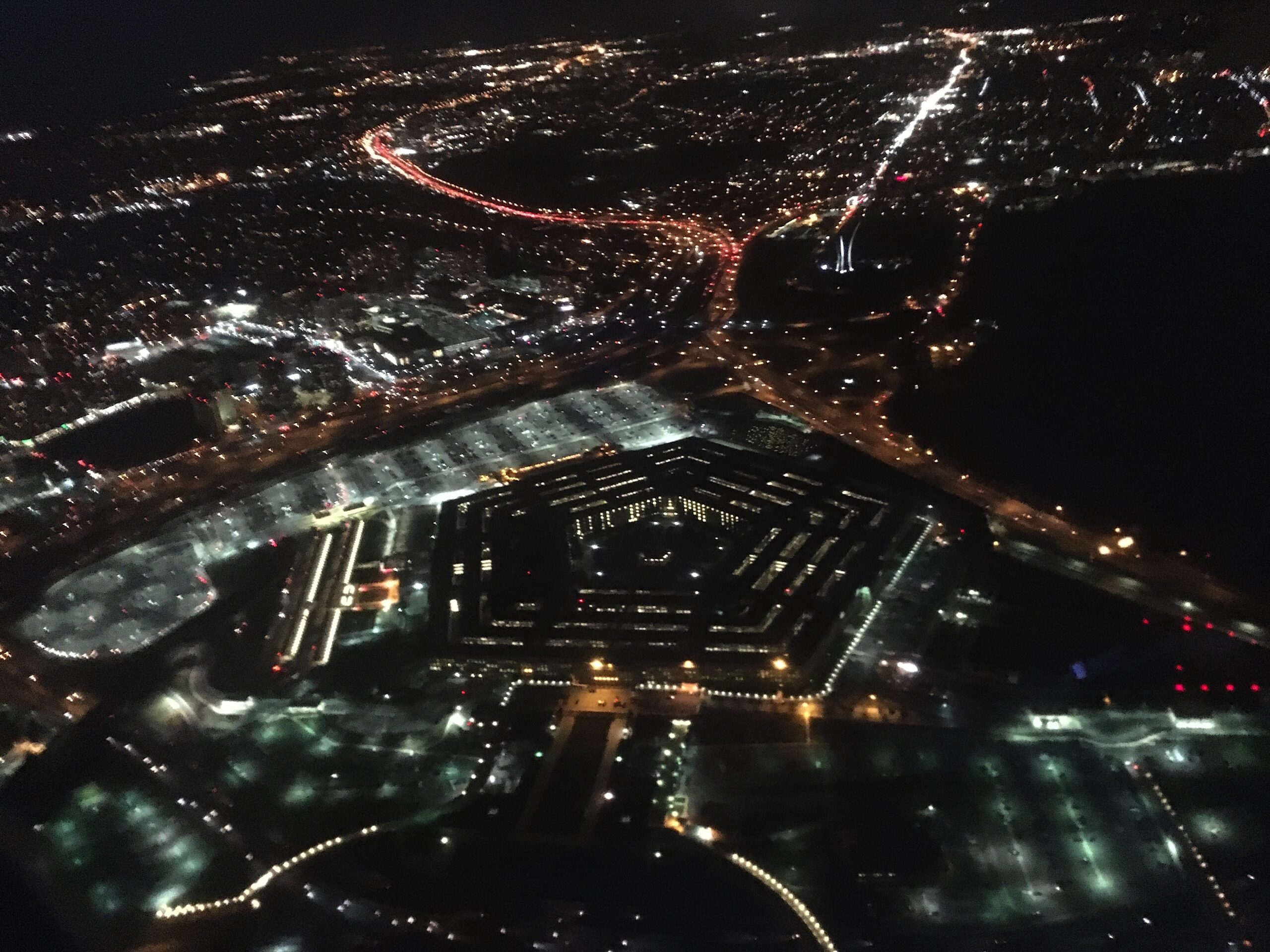
Aerial view of Pentagon at night. (Joe Lauria)
The Pentagon itself has undergone remarkable corporate growth within its bureaucracy since 2001. Examples include, but are hardly limited to, the corporation Concurrent Technologies running and managing portions of the Under Secretary for Personnel & Readiness; Strategic Analysis Inc. guiding research and engineering objectives within assistant secretaries’ offices; and E3 Federal Solutions covering over three dozen “separate offices headed by senior level individuals” within the Office of the Under Secretary for Policy.
On April 30, 2019, the Institute for Defense Analysis (based out of Alexandria, Virginia) was contracted to support DOD with research, analyses, technical evaluation, and test & evaluation involving “comprehensive evaluation of national security issues, including systems and technologies at all stages of development, deployment, and use.” Corporations have also overrun Washington Headquarters Services, the military’s primary stand-alone administrative unit.
The Physical & Environmental Cost
War is when the ruling class of one country sends the working class of that country off to fight the working class of another country. Over 7,000 U.S. Armed Forces personnel and 8,000 mercenaries have died in the post-9/11 wars. Nearly one million veterans have filed disability claims with the Department of Veterans Affairs.
Yet, these numbers do not account for the active duty troops and military veterans who commit suicide, live mentally maimed, or inflict ripples of misery throughout U.S. society as a result of the trauma they experienced while in uniform.

A former explosive ordnance disposal technician who suffers from PTSD and traumatic brain injury after combat tours in Afghanistan and Iraq displays a mask he painted. Hanover, Pa., April 5, 2017. (U.S. Air Force, J.M. Eddins Jr.)
Untold millions of humans have died from U.S. military and intelligence activity worldwide since the National Security Act of 1947, which entrenched armed bureaucracies and fortified the MIC. Well over one million humans have died across the globe as a direct result of Washington’s post-9/11 wars.
Wall Street, U.S. war corporations, and their pliant politicians are responsible for the post-9/11 fatalities — be they Afghan, Colombian, Filipino, Iraqi, Libyan, Pakistani, Somali, Syrian, U.S., Yemeni. Any given war corporation misdirects the public from the reality of this veritable massacre by saying it has “delivered strong operating results, demonstrating the power of our business portfolio.”
Mercenaries are personnel who work for war corporations, nominally under a nation’s flag, while receiving greater financial pay than their peers in military uniform. Money and generations of propaganda lure portions of the working class into becoming mercenaries. War corporations make a lot of money selling armed mercenaries to the Pentagon. These mercenaries die, too. So why use armed mercenaries? The ruling class knows it needs to keep the deaths of uniformed troops at a minimum.
Too many soldiers, sailors, airmen, and Marines dying (killed in the optional wars pushed by that very war industry) would draw unnecessary attention to the racket. Mercenaries die in war zones, absorbing deaths that would otherwise bloody the military ranks. This mortality-accounting loophole allows the Pentagon and Capitol Hill to cite low casualty figures.
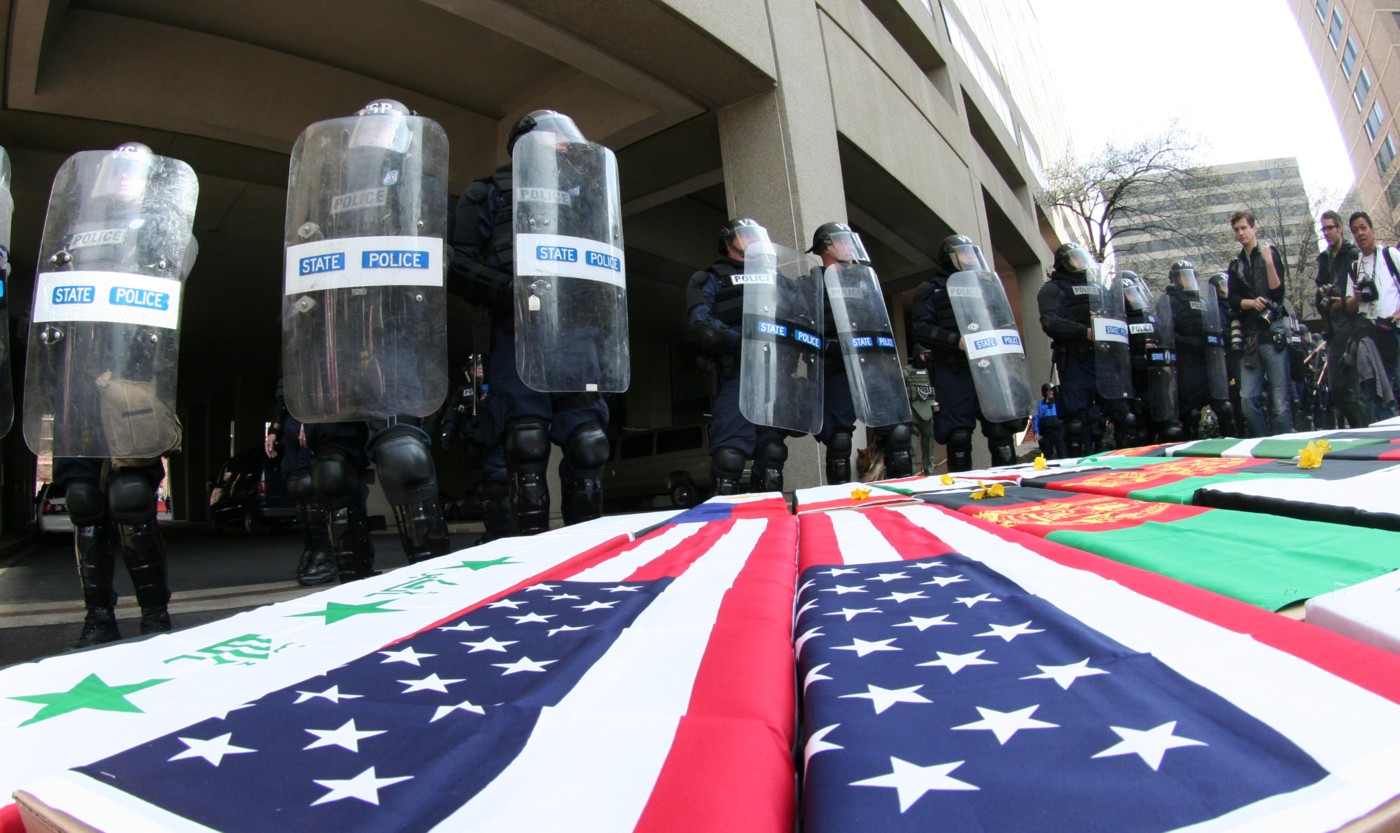
Mock coffins placed near the offices of military contractors in Arlington, Va., during a protest against the Iraq war, March 21, 2009. (Victor Reinhart, CC BY-SA 3.0, Wikimedia Commons)
Additionally, using mercenaries keeps conscription—in other words, reinstating the draft—off the table. Conscription would expand the burden of war into the upper classes of society, dragging in the sons and daughters of the ruling elite. That would be unacceptable to MIC elites. Mercenaries keep the war machine firing on all cylinders.
Capitalists profit when they adeptly shift costs onto others (humans, other animals, the planet itself). This includes enforcing poor labor safety, crushing labor unions, and polluting the natural world. We, the people, see so much pollution and harm because that’s how the system is designed. Those are intentional byproducts of capitalism.
The military-industrial-congressional complex is the world’s worst polluter. This pollution comes in many forms, including:
- Military use of polluting platforms (e.g. aircraft, most ships, land vehicles).
- War industry manufacture and distribution of goods and services causes a great deal of pollution. Corporate opacity prevents the public from understanding the extent of industry’s environmental contamination. For example, as The Orlando Sentinel recently reported, “Lockheed Martin created an ‘environmental nightmare’ at its facility off Sand Lake Road by mismanaging hazardous toxins, which contaminated nearby workers who were later diagnosed with multiple sclerosis, brain lesions, cancer and other diseases, newly filed lawsuits say… Instead of carefully managing the waste, attorneys alleged Lockheed Martin stored toxins in leaking storage tanks, collected and transported waste in leaking underground piping systems and dumped tons of toxic waste sludge inside trenches dug at the Orlando facility.”
- The U.S. war industry uses depleted uranium (DU) in a lot of armor and ordnance because DU is very dense. The U.S. military’s use of DU, a chemical weapon, creates public health emergencies wherever it detonates overseas.
- Construction firms build and repair military installations of all sizes. Corporations such as AECOM, Fluor, Jacobs, Parsons, RQ Construction, Tetra Tech, and Whiting-Turner are among the Pentagon’s go-to engineering and project management firms.
- Fossil fuels power all this military construction — from cranes to backhoes to bulldozers to dump trucks to the private employee vehicles commuting to and from the work sites to the fossil-fuel-intensive manufacture of concrete and steel. Not a single structure is erected without immense, unmeasured fossil fuel pollution. The Pentagon does not require construction firms to reuse, repurpose, and recycle materials. Military construction physically lays the foundation that extends the permanent warfare state.
Pollutants contaminate soil and groundwater at current and former military and industry sites across the United States. Pollutants can include radioactive waste, rocket fuel, components of buried chemical and conventional weaponry, exploded ordnance, degreasers and other chemical solvents, petroleum products, coatings (such as hexavalent chromium, used in protecting missiles, aircraft, and certain land vehicles from corrosion), and fire retardants.
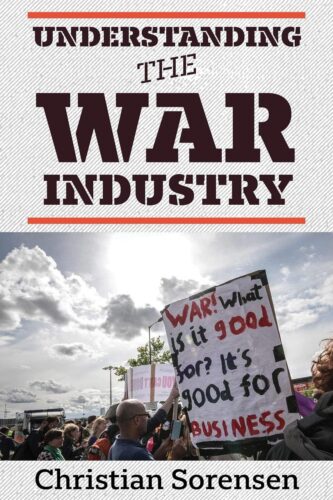 The substances used to put out aircraft fires are highly toxic. Polychlorinated biphenyl and polyfluoroalkyl substances are common. Current and former military sites across the U.S. are riddled with pollutants, from the Aleutian Islands to the Atlantic seaboard. Many of these sites are in or around populated areas, harming the working class.
The substances used to put out aircraft fires are highly toxic. Polychlorinated biphenyl and polyfluoroalkyl substances are common. Current and former military sites across the U.S. are riddled with pollutants, from the Aleutian Islands to the Atlantic seaboard. Many of these sites are in or around populated areas, harming the working class.
Military activities and infrastructure keep U.S. society headed in the wrong direction, postponing the necessary demilitarization of U.S. society and demobilization of the war industry. Demilitarization and demobilization are the only healthy, non-polluting ways forward.
How does the Pentagon clean up its pollution? By turning to Corporate America, of course. Many corporations tackle the Pentagon’s pollution. The bigger ones, such as Jacobs and Tetra Tech, are best known for their engineering and construction prowess.
In exchange for cash, Corporate America conducts studies and environmental assessments, the positive passage of which unbridles corporate greed on the road to more profits; prepares plans, drafts documents, and issues reports; surveys sites, oversees wetlands, and supervises land use; writes up Comprehensive Environmental Response, Compensation, and Liability Act documentation; estimates costs; dredges muck; monitors environmental compliance; peruses Executive Orders; plots basing patterns; reviews the National Environmental Policy Act; removes contaminated soil; excavates, characterizes, separates, and transports waste; studies socio-economic issues and demographics; drafts emergency response preparedness; disposes of radioactive material; and runs community outreach and strategic engagement.
Public relations are often packaged as part of a corporation’s environmental remit; total honesty regarding the polluting footprint of military and industry rarely comes to light.
The Burn Pits
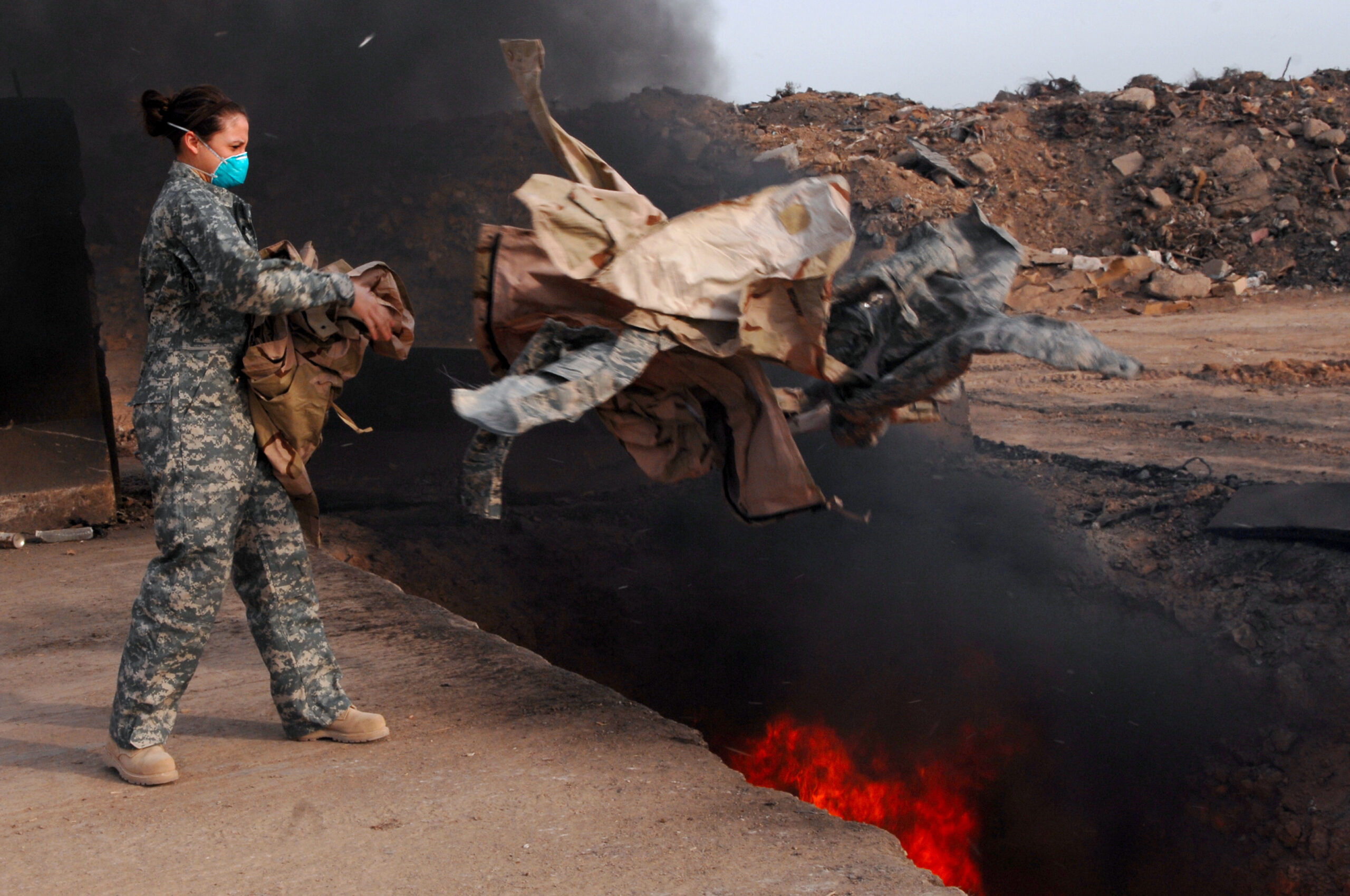
U.S. Air Force member tosses unserviceable uniforms into a burn pit, March 10, 2008. (U.S. Air Force, Julianne Showalter)
The U.S. Armed Forces and the corporations running U.S. military bases in Iraq and Afghanistan burned trash in open-air pits. Routinely incinerated were appliances, batteries, fecal matter, medical waste, paint thinner, vehicle parts, and a variety of plastics. Jet fuel, itself a carcinogen, was often used to ignite the blazes. Severe medical problems afflicted anyone who crossed paths with the black clouds and the particulates spewing from these burn pits.
In October 2014, the Department of Veterans Affairs finally established a registry to track veterans who believed they were exposed to burn puts during their time in Afghanistan or Iraq. Tens of thousands of veterans have enrolled in the registry.
In autumn 2016, the Government Accountability Office affirmed that the Pentagon needed to study exposure to burn pits and the long-term health problems that may result. The GAO even accused the Pentagon of taking too long to study the problem. Data indicate a rise in certain types of cancers among veterans over the past two decades of war, McClatchy reported in October 2019.
Nonetheless, the National Academies of Sciences, Engineering, and Medicine published research in September 2020 concluding that there was insufficient data to establish a firm link between many severe pulmonary diseases and deployments to Afghanistan and the broader Middle East.
The Pentagon has no plans to help Iraqis or Afghans who were exposed to its burn pits.
Central Command
The Pentagon has divided the world into geographical areas of responsibility so it can better manage the imperium. U.S. Central Command (CENTCOM) is the geographic combatant command in charge of the greater Middle East. CENTCOM stretches from Kazakhstan in the north, Afghanistan and Pakistan in the east, westward across the Arabian Peninsula, ending in Egypt.
U.S. Africa Command (AFRICOM) is in charge of the African continent, minus Egypt. CENTCOM and AFRICOM currently receive the brunt of the MIC’s violence because they are regions rich in natural resources and because their restive populations do not easily bend to the will of capital.
The ruling class deploys the U.S. Armed Forces to Middle Eastern countries — countries where the Armed Forces directly fight (e.g. Afghanistan, Iraq, Syria) and countries where they launch aircraft, conduct information gathering, store matériel, train, and reside (e.g. Bahrain, Kuwait, Qatar, Saudi Arabia, Jordan and the UAE).
The U.S. ruling class prefers to locate military installations in anti-democratic countries, since, if the working class of the Middle East had their say, U.S. military forces likely wouldn’t be allowed in. Countries run by anti-democratic regimes house some of the Pentagon’s biggest and most active overseas installations (e.g. al-‘Udeid Air Base in Qatar).

The Combined Air and Space Operations Center (CAOC) at Al Udeid Air Base, Qatar, provides command and control of air power throughout Iraq, Syria, Afghanistan and 17 other nations. (U.S. Air Force, Joshua Strang)
Touring a Base
You dismount a corporate ride and stroll around a U.S. military installation — say, Camp Arifjan in Kuwait. You run into a variety of corporations carrying out different governmental tasks. Mission 1st Group manages network and communications infrastructure. Your peer stateside receives you on his new audiovisual equipment, maybe purchased from Wildflower International. Perhaps he works for a U.S. branch of the British firm Serco, which manages programs, runs intelligence logistics and air operations centers, and plans operations for CENTCOM.
Your stomach growls, so you end the call and exit the building, which was built by CH2M Hill (now Jacobs). You pass a group of AECOM personnel rigging up infrastructure to support U.S. Navy surveillance operations. CGI Federal maintains nearby software.
 On your way to the chow hall, which is run by Vectrus, you pass a warehouse in which AECOM personnel using General Dynamics software sort and track weaponry and matériel. Leidos expertise helps account for munitions. You glance to your right at the distant gate, where SAIC personnel are arranging the latest entry control systems.
On your way to the chow hall, which is run by Vectrus, you pass a warehouse in which AECOM personnel using General Dynamics software sort and track weaponry and matériel. Leidos expertise helps account for munitions. You glance to your right at the distant gate, where SAIC personnel are arranging the latest entry control systems.
Triple Canopy personnel guard the gate. Vectrus personnel are fueling the military police vehicles. Members of the 595th Transportation Brigade are driving cargo (unloaded at ports by Cargo Transport System) onto the base. KBR runs morale, welfare, and recreation, including the gym you hit every morning.
The chow hall isn’t open yet, so you duck into a safety briefing, featuring materials from Kaiyuh Services. U.S. construction firms build military infrastructure through which U.S. war corporations then route profit.
The Afghan Gravy Train
To take another practical example, U.S. activity in Afghanistan also illustrates the profitable nature of war.
Corporations began selling weaponry to the Afghan government shortly after Hamid Karzai assumed presidential authority in December 2001. The longer the war lasted, the better U.S. weapons brokers became at dealing. Sales to Afghanistan have been thorough, spanning Harris radios, Northrop Grumman reconnaissance aircraft, PAE training, General Dynamics rockets, L3 fuses, AM General and Textron vehicles, Colt rifles, Capco training bombs, and Jacobs logistics.
Notable corporations involved in building up the Afghan Air Force have included AAR, Lockheed Martin, MD Helicopters and Sierra Nevada Corporation. Billable categories include support equipment, transportation, repair, and sustainment. U.S.-directed plans for the Afghan Air Force aim for 80 Lockheed Martin UH-60 helicopters in Afghan possession by 2030, according to a 2019 New York Times report.
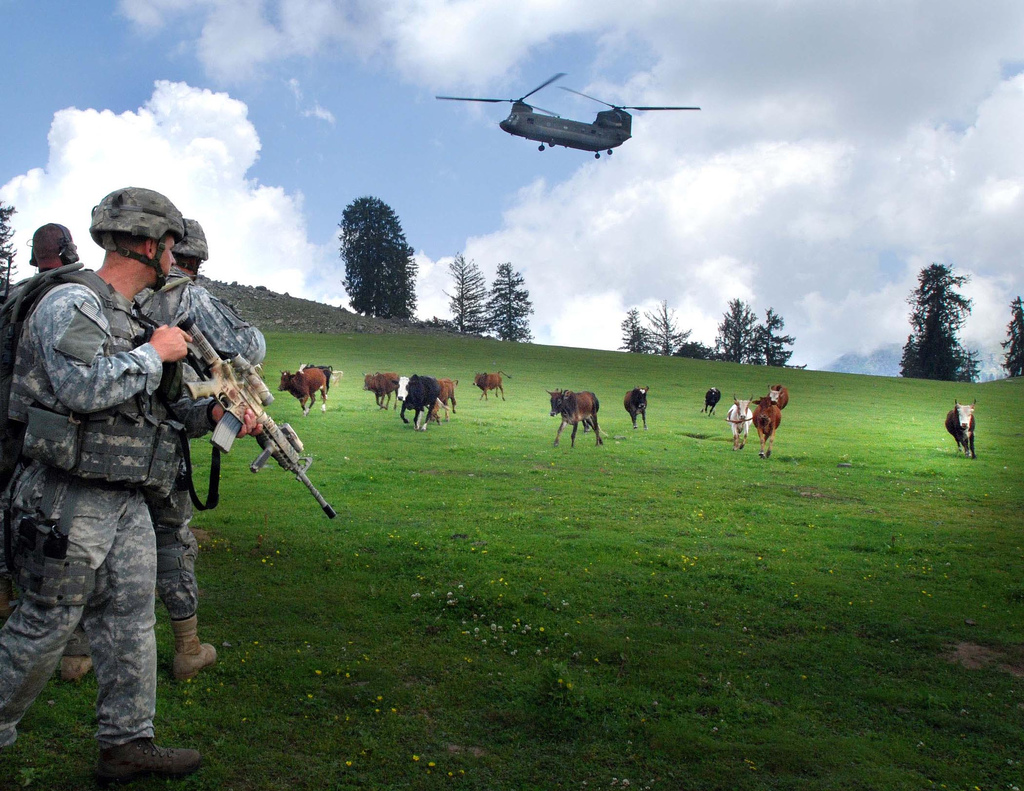
U.S. soldier watches cattle run while a CH-47 helicopter prepares to land, near Forward Operating Base Naray, Afghanistan, 2006. (U.S. Army)
Sales to Afghan forces have also included avionics maintenance equipment for “counter narcotic activities,” a 2016 contract announcement attests. Opium production has skyrocketed since the U.S. Armed Forces began occupying the country. Corporations have even managed Afghanistan intelligence operations. One such program cost $457 million and didn’t meet a bare minimum of standards.
Corporate goods and services have formed the bulk of the U.S. presence in Afghanistan. The corporate occupation force in Afghanistan is broad, including EXP (Chicago) electrical maintenance; Boeing drones, equipment, and field service representatives; AC First (a joint venture between construction giant AECOM and the IT firm CACI) logistics, maintenance, supply, and transportation; and CACI IT-based intel ops. Other services include Jacobs logistics and Mission 1st Group project management and network infrastructure. PAE has maintained military vehicles at Hamid Karzai International Airport.
SAIC runs protection services around the country. Multiple corporations work on blimps deployed above U.S. military installations to keep an eye on things. For a pretty penny, such corporations as AAR and Columbia Helicopters have transported U.S. military forces, cargo, and casualties across the country. The aforementioned companies comprise a small sample of the corporatized forces that have occupied Afghanistan. All told, there were more than seven contractors for each U.S. military service member in Afghanistan prior to the current military drawdown.
For year after year, war industry officials, high-ranking military officials, and industry think tanks insisted that the U.S. military was making “progress” in Afghanistan. They were lying. In late 2019, The Washington Postreleased its in-depth investigation into these official assertions of progress. The Post’s reporting was based on thousands of pages of government documents and hundreds of interviews. “U.S. officials constantly said they were making progress. They were not, and they knew it,” the Post summarized.
In early 2021, a congressionally mandated panel, the Afghanistan Study Group, issued its own recommendations: stay in Afghanistan longer. The bulk of the panel was comprised of war profiteers, members of war industry think tanks (e.g. Institute for Study of War), consultancies within the war industry (e.g. Cohen Group, WestExec), and elites with vested professional and financial interests in war. For example, two of the three co-chairs were retired general Joseph Dunford (sitting on Lockheed Martin’s board of directors) and former Senator Kelly Ayotte (sitting on BAE Systems Inc.’s board).
Dunford asserted, “It’s not in anyone’s best interest right now for a precipitous withdrawal from Afghanistan.”
Post-9/11, the MIC successfully achieved an increase in bombing rates in the Middle East, regardless of which capitalist faction sat in the White House. The pursuit and bombing of sundry populations in the Middle East, which is the backbone of post-9/11 military action, is a direct transfer: money from U.S. taxpayers and from sold Treasury marketable securities to U.S. war corporations, and ordnance from war corporations to sovereign land in the Middle East.
These are one-way routes, casting wealthy executives and dead civilians in their wake.
This is the fourth in a five-part series by the author.
Christian Sorensen is an independent journalist mainly focused on war profiteering within the military-industrial complex. An Air Force veteran, he is the author of the recently published book, Understanding the War Industry. He is also a senior fellow at the Eisenhower Media Network (EMN), an organization of independent veteran military and national security experts. His work is available at War Industry Muster.
The views expressed are solely those of the author and may or may not reflect those of Consortium News.
Please Support Our
Spring Fund Drive!



There are some very unexpected corporate players in this game, notably the Alaska Native Regional Corporations and their subsidiaries. Due to some serious sleight of hand, the ANC’s can spin off a steady stream of subsidiaries
that qualify under Section 8 of the Small Business Act as ‘small businesses’ which qualify for no-bid (sole source)
contracts with the United States military. These subsidiaries are a big presence in the service sectors of military bases. It’s a very convenient system for all involved. Except for the ethical question of how these activities correlate with the Native Values which all the Regional Corporations extol on their corporate website Home Pages.
You know elsewhere I said today (literally) in/on the world wide web that there could be 1 trillion (with 12 zeros after the 1) homo sapiens living on planet earth in the future, and I have faith, but not if so many profit from war and this mindset continues because…..
~
Oh gracious, why ought I type what I’m thinking?
~
What a travesty is all is and my heart goes out to the Palestinian family who lost their son, their brother, their nephew, their niece, their babies, their hopes for their future. The lost their uncle, they got pushed of the land, they were shot in cold blood and left to bleed away on the street and die a lonesome death. Wonder what all these individuals, they were innocent, thought as the last bit of blood left their body? What a great loss it is and it is the same old broken record. Effing 20th century thinking and it is coming to an end. It will be swift.
~
Thanks for all the names in this article – they all deserve to be boycotted if they are profiting on WAR and suffering of innocence and so they need to look into the mirror and decide what it is they honor.
~
Then let lady justice work it all out in a blender I reckon.
~
Eff em all.
~
BK
~
ps – funny thing is so much MORE currency would be so easy if we just worked mutually instead of what we been doing………..now or never….tick, tick, tick, tock, tick, tock, tick – the clock is a ticking and tocking and the time of……oh screw it, why should I say it.
Reading Mister Sorenson’s description was impressive but gave me a headache.
Several quotes stand out.
“All told, there were more than seven contractors for each U.S. military service member in Afghanistan prior to the current military drawdown.”
How would you manage something like that in a real war?
Real war? One where the enemy is comparable in strength.
And then.
“Additionally, using mercenaries keeps conscription—in other words, reinstating the draft—off the table. Conscription would expand the burden of war into the upper classes of society, dragging in the sons and daughters of the ruling elite. That would be unacceptable to MIC elites. Mercenaries keep the war machine firing on all cylinders.”
What effect does the absence of conscription have on the MIC ?
I agree with Mister Sorenson absent a real threat to our country.
Fabulous writing Christian. Thank you.
“To make more money, more and more aspects of life must be pulled into capital” – unfettered capitalism. It is self destructing.
China is not communist, it is corporatist. The United States is no longer simply capitalist, it is corporatist. Pot meet kettle. How did Mussolini characterise corporatism? Benito’s reported words on the subject were, “Fascism should more appropriately be called Corporatism because it is a merger of state and corporate power.”
The most hideous aspect of this evolution seems to have been that America’s fascist proclivities have made enemies of not only m0st of the rest of humanity but of Mother Earth as well, as made so clear in this article. There is no entity on the planet that squanders as many irreplaceable resources or wantonly destroys as many living ecosystems as fast and completely as the US military does even when it is just practicing the mass murder of it fellow conspecifics.
(Why didn’t my municipality’s contracted solid waste disposal company think of open burn pits? Would be so much easier and cheaper! And their take of our non ad valorum property taxes would be even more generous. There are still more corners to cut, especially if military efficiencies are applied!)
These “Tales from the Crypt” are always so scary! I mean REALLY scary, as in reality based.
Follow the $ , which are mostly directed against Gaia.
Realist – ha, ha. Most appreciated what you say.
~
That is basically the only reason I separate out current plastics into my recycling bin cause I’m hoping wiser minds have figured out the best use for these wasteful materials in the first place is to separate them out and BURN them for all the energy they contain after they served their short-term wasteful purpose. Then, in the current day, this energy could be put to better uses like powering electric vehicles or possibly making lithium batteries, but when you run the numbers on that sort of thing, then the math gets complicated. Same is true for solar cells, but don’t try to tell a Millennial this sort of thing cause they will scoff at your ignorance being they really don’t have the wisdom of age and their best skill these days is pushing buttons. Sorry, if that seemed to be over-generalizing, but I’m in a bad mood today, so cut me some slack will ya? So much plastic is so wasteful, but solutions are waiting to be discovered and I already have several I’m just biding my time on revealing cause I know what I’m talking about and my children are Millennials, so I ought know (ha, ha – I hope they don’t read this).
~
What is not complicated is that most plastics today should just be BURNED and then their production needs to diminish except for those things that are most crucial. Meanwhile, the chemist, and most importantly, the chemical engineers can come up with a plastic or two that were designed to be recycled from the get-go. So easy to just go round and round if you know what I’m getting at.
~
If I find out that all my trouble for separating out the plastic results in it just being disposed anyhow in the landfills or in the oceans, then mother eff it, I’ll just throw it in the trash. As for glass, I’m really not sure it makes sense to try to recycle that, but what the hell do I know…..I’m just a chemical engineer with a bad attitude.
~
Peace,
BK